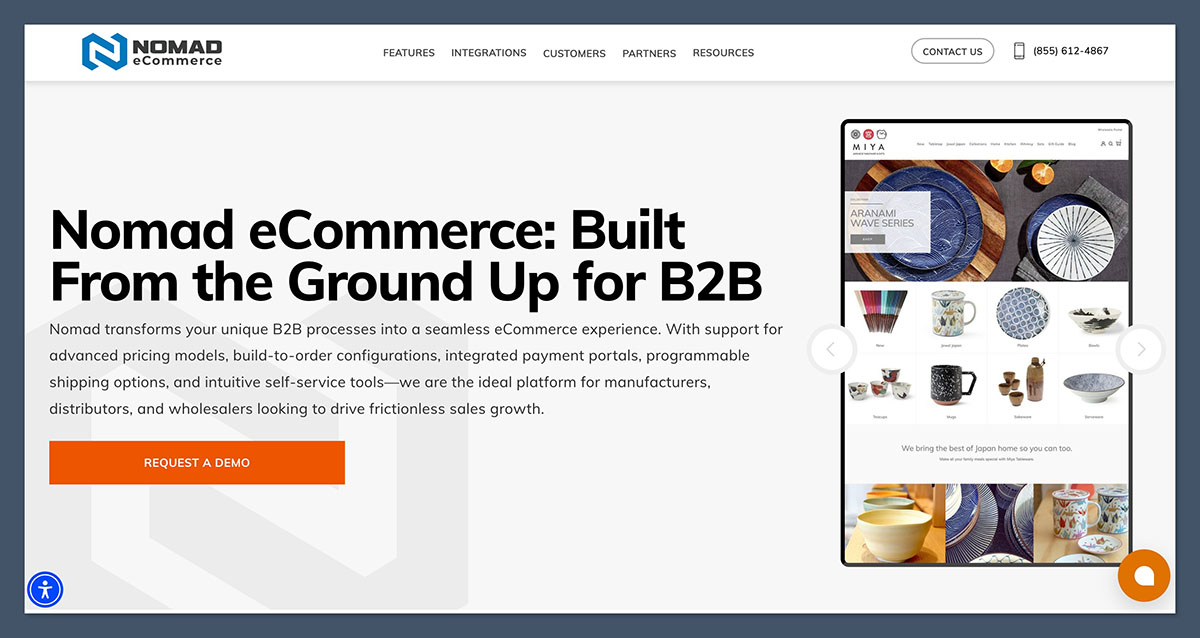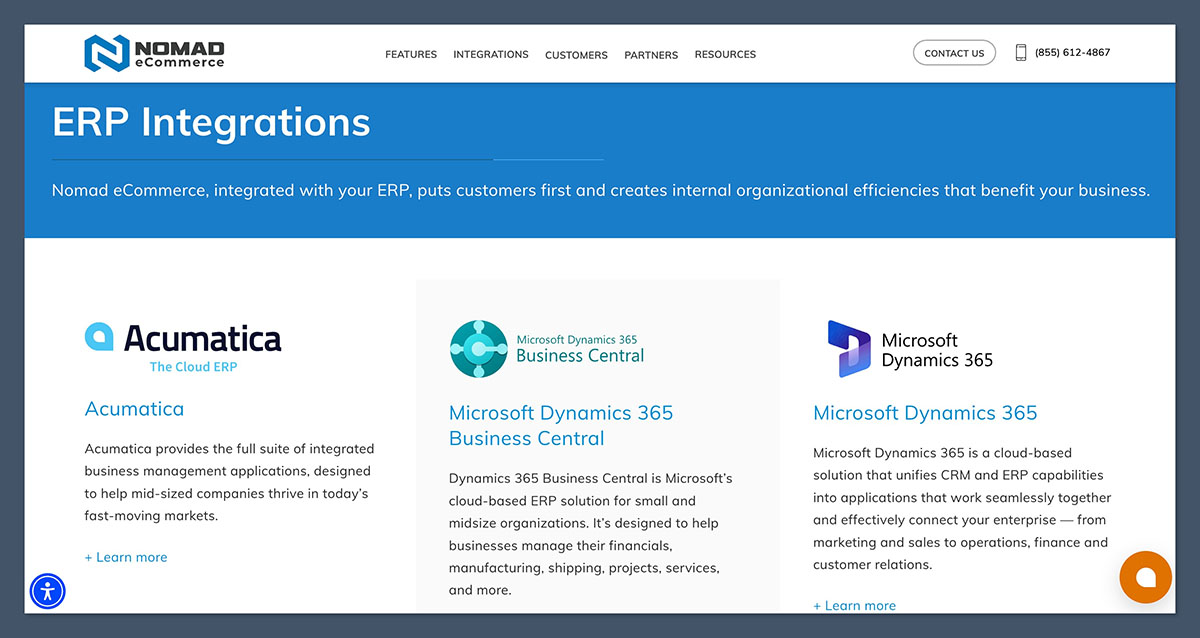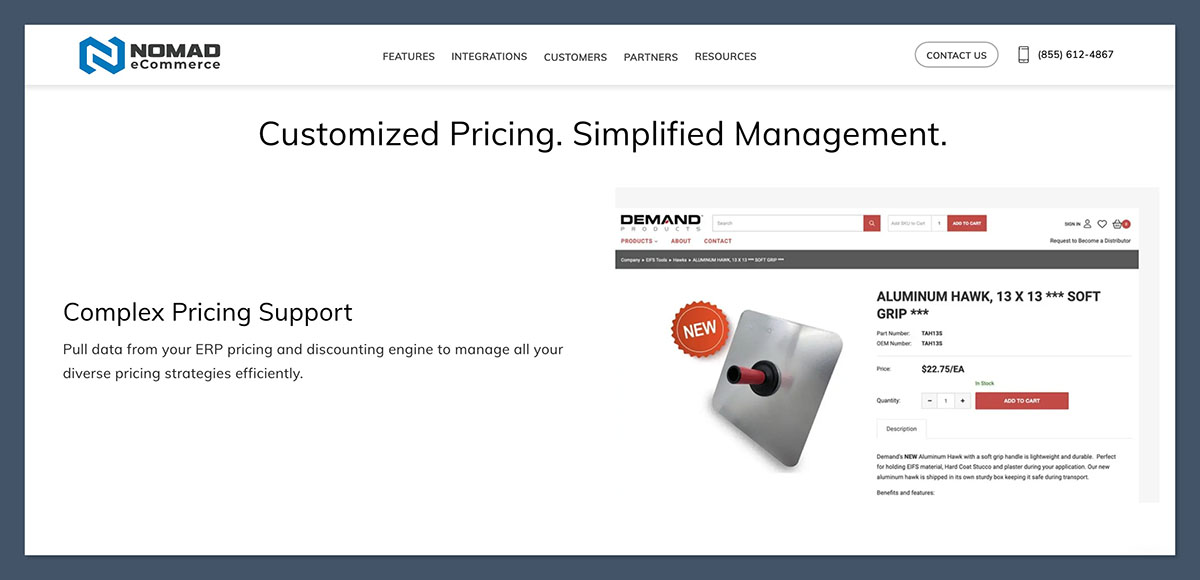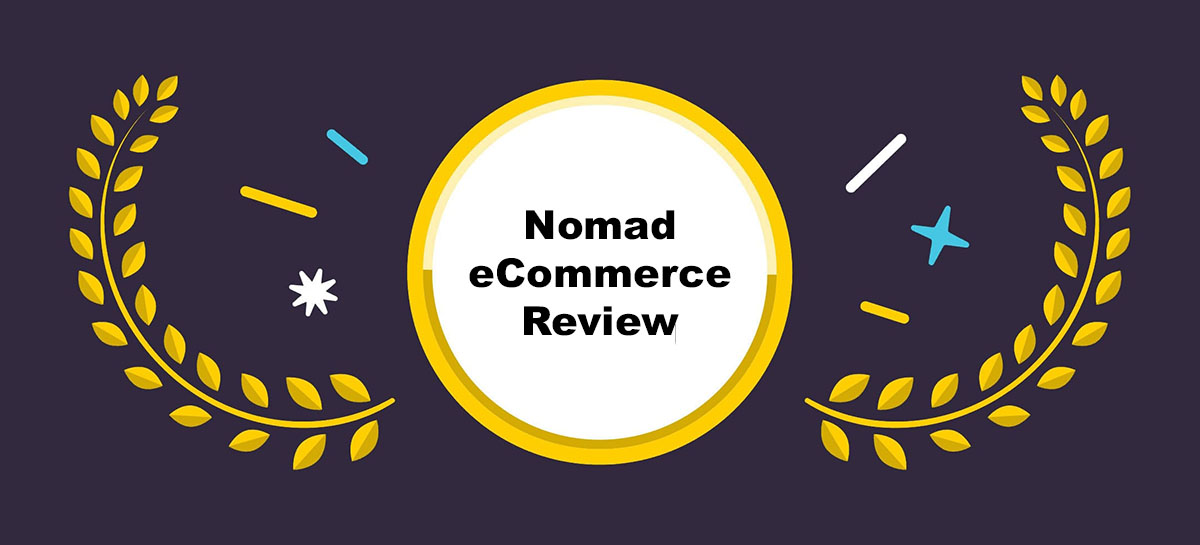Over the years, I’ve spent a lot of time experimenting with a bunch of different ecommerce platforms – from the world-renowned giants like Shopify, to compelling niche options like “Art Storefronts”.
Nomad Ecommerce is one of the few options I’ve tried focusing on B2B sellers.
That’s not to say there aren’t other options out there (like Shopify and BigCommerce, which have their own B2B solutions).
But Nomad Ecommerce is definitely interesting – combining manufacturing, distribution, and wholesale solutions into one platform.
It’s not just another “plug it in, turn it on” solution; it caters to complex B2B processes, from unique pricing and intricate product configurations to advanced shipping needs and ERP integrations.
Obviously, that means it won’t appeal to everyone – but if you’re looking for a system that really takes B2B business needs into account – keep reading, Nomad might be right for you.
Quick Verdict: Pros and Cons
After snapping up a demo and giving Nomad Ecommerce a spin for myself – I have to say it’s a pretty great option for companies looking for a serious B2B-focused system.
It’s really good at helping organizations handle the complex parts of B2B selling, like managing complex pricing, and product configurations. I also love the in-depth ERP integrations.
That said – it’s not the most beginner-friendly choice.
There’s a definite learning curve if you’re used to simpler eCommerce systems. Also, since Nomad is focused on quote-based pricing, it might cost more than some off-the-shelf platforms, especially if you only need basic online selling features.
Pros:
- Powerful B2B pricing models
- Flexible product configurations
- Seamless ERP integration
- Customer-specific checkout and shipping options
- Comprehensive self-service features
Cons:
- Learning curve for new users
- Potentially higher costs (quote-based model)
- Targeted mostly at B2B, so there’s less emphasis on basic retail
Nomad Ecommerce Review: Core Features

Usually, if I was reviewing a platform like Wix or Squarespace, I’d spend a lot of time talking about web design tools and marketing features.
Nomad ecommerce is a little different. First, you don’t really get a lot of “design” options. Every business gets a template with the basic stuff – like headers, footers, and user menus.
During your “onboarding” session, the Nomad team will walk you through the process of configuring your site to match your brand.
It’s simple enough, and from what I can see the designs end up being professional and mobile responsive – but if you’re looking for a lot of creative flair, you’re going to miss out here.
Similarly, from a marketing perspective, Nomad doesn’t have a ton of options available.
You’re mainly going to be relying on integrations with tools like Klaviyo for campaigns – and I couldn’t find a dedicated blogging option.
Still, that’s not to say that Nomad doesn’t have some great selling points – let’s take a closer look at some of its core features.
B2B Customer-SPECIFIC Pricing Solutions
One of the biggest strengths of Nomad Ecommerce is its ability to handle complex B2B pricing structures.
I’ve seen many eCommerce platforms promise “advanced pricing,” only to fall short when it comes to applying individualized discounts or intricate promotional rules.
Nomad, by contrast, truly leans into the idea that “your negotiated price is your negotiated price.” Thanks to its tight integration with ERP systems, Nomad pulls in pricing data directly from whatever logic or discount structure you already have in place.
I really love how the system generates custom prices, using caching mechanisms to ensure customers see the right price instantly.
You also get comprehensive control over pricing flexibility, with things like cost-plus, value-based, and competition-based pricing templates. You can even create custom pricing structures for different customers – which is handy in B2B.
Product Configuration Capabilities
This is another big seller for Nomad. Every customer gets a “configurator” that syncs directly with your ERP, pulling out data, parameters, configuration rules, and bills of materials.
Customers can select components, receive real-time rules-based responses for each choice, and essentially create their own orders with minimal effort.
This means that if you’re producing something that needs custom welding, painting, or bundling of multiple components, Nomad walks both you and the end customer through a structured process – which makes life a lot easier.
Once an order is placed, it flows directly into your ERP as a sales order, with a bill of materials, and the work orders required.
On top of that, you also get features like “intelligent quoting” for especially complex or engineering-heavy builds.
In those scenarios, Nomad suppresses real-time pricing and moves the order into a quotes workflow directly within your ERP.
If you’ve got a business where nothing is truly “off the shelf,” this level of automation and transparency could be invaluable.
Custom Checkout and Shipping
One of the biggest overlooked challenges of B2B eCommerce is shipping complexity.
Many platforms try to paste on features that were really designed for direct-to-consumer selling, leaving B2B sellers to figure out custom shipping routes, LTL freight, or multi-warehouse dispatches.
Nomad eCommerce aims to solve that with a checkout and shipping module that feels perfect for B2B.
Thanks to the ERP integration, Nomad can pull in up-to-date shipping information and account for factors like lead times, inventory availability, or split shipments.
Customers can see accurate shipping estimates and decide on freight carriers or methods that align with their own requirements.
I also love that Nomad offers enough flexibility to include custom checkout questions, region-based shipping, and any specialized sales tax or discount logic without needing multiple third-party apps.
Ultimately, it pulls all of the puzzle pieces of checkout and shipping management together into one environment, which makes life a lot easier.
Plus, it integrates directly with a lot of shipping providers, so you can manage everything under one roof.
Payment Portals
Speaking of checkouts, Nomad also offers access to convenient payment portals.
Most B2B businesses spend a decent amount of time dealing with net terms, partial payments, credit limits, and other things that make payments difficult.
Nomad addresses this by allowing customers to securely access their account information, payment histories, and invoices – directly pulled from your ERP.
Once they have access to this data, they can make payments via ACH, credit card – or other electronic methods.
Nomad also handles “reconciliation”, sorting all of your data into one convenient box so you can keep track of things a lot easier, and minimize potential risks.
Because everything syncs in real time, you don’t end up with mismatched records in your ERP.
Self Service Solutions
I’ve already touched on how Nomad Ecommerce makes self service a little easier with secure customer accounts – but there’s more to the platform than just that.
You can set up features that allow buyers to reorder their favorite products in just a single click, or add previous items to their cart instantly – saving them a lot of time and headaches.
Business leaders can also access customer and vendor accounts on their behalf (with secure login details) to take over the transaction process.
I also like that Nomad supports advanced searches for customers who know exactly which product attributes they need.
Rather than forcing them to wade through irrelevant SKUs, they can filter by specific models, part numbers, or other custom criteria.
Enriched ERP Data
You’ve probably noticed by this point that a major differentiator of Nomad Ecommerce is the fact that it combines ecommerce solutions with intuitive ERP access.
What I really love about the platform is that it doesn’t just “interact” with your ERP system – it improves it.
You can use Nomad to automatically compile ERP information and enrich it with other data from third-party systems, your backend, or CMS and CRM platforms. The system automatically handles all of the “data sourcing” and consolidation tasks in a few minutes.
What’s more, Nomad is built to handle even the weird or highly specialized fields that many ERPs rely on. If you’ve got custom user-defined fields or some specialized workflow for an industry-specific piece of data, Nomad can ingest and display it.
In practical terms, that means your site stays up to date without the repeated grunt work of double entry or manual reconciliation.
And for your customers, that translates to accurate pricing, correct product info, and an overall smoother experience.
The payoff is huge for businesses that previously struggled with disconnected front-end and back-end systems.
Nomad Ecommerce Integrations

Obviously, the biggest “collection” of integrations you’ll get from Nomad are linked to the ERP space.
This platform links seamlessly with virtually every ERP you can think of, from Microsoft Dynamics 365 Business Central, to Acumatica, Oracle Netsuite, and Epicor.
There are other third-party integrations available too, though, for things like tax and finance management (Such as tax jar), marketing campaigns (Klaviyo), shipping (Fedex and UPS), payment processing (PayPal, etc), and live chat.
You can also contact the team if you need any extra support creating custom integrations.
Nomad Ecommerce: Pricing, and Customer Support
I really don’t have much to say about Nomad’s pricing – because it’s not actually listed on the website.
I requested a quote to see what kind of price I’d be paying – but it seems almost pointless to share that here, as each price is built specifically for different customers.
Ultimately, the best thing you can do is contact the team directly and ask for your own quote.
I will say you should expect to pay a higher price than you would for a standard ecommerce platform. Think closer to something like Shopify Plus, than Shopify Basic.

Still, you could save yourself a lot of time and money with all of Nomad’s intuitive tools. Plus, once you are signed up, you do get some pretty decent customer support. The company offers onboarding and training guidance, as well as email and phone-based technical support.
That’s a good thing, because in my opinion, setting up Nomad Ecommerce can be a little tricky – so you’re going to need extra help wherever you can get it.
Nomad Ecommerce Review: The Verdict
So, is Nomad Ecommerce the ideal platform for every online seller? Definitely not.
If you’re looking for a simple, straightforward system – this isn’t it. However, if you want a platform that’s specially designed for B2B companies in the manufacturing, distribution, or wholesale space, Nomad is absolutely a winner.
If you’ve ever felt limited by more generic online store builders – constantly fighting to adapt them for your distribution or manufacturing workflows – Nomad might be exactly what you’ve been waiting for. J
ust be prepared for a higher learning curve (and potentially a higher price tag) than you would expect from other platform vendors.






